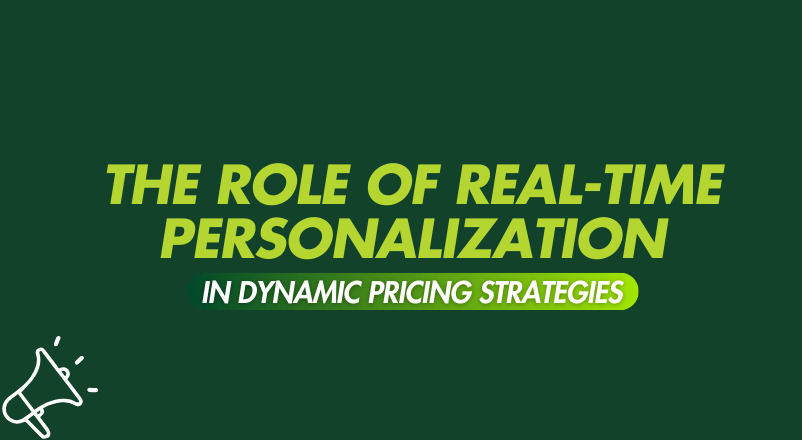
Ever seen a price page and thought about whether the prices reflect what you actually get or is it like every other price for every other customer?It has happened to all. Static prices and generic experiences are no longer enough for users, who now expect relevance and fairness in their interactions.Today’s customers demand much more than wonderful features; they expect reasonable, flexible pricing according to their needs, along with experiences that seem customized to their requirements. That’s where two master strategies come into play: dynamic pricing and real-time personalization.
Dynamic pricing as a strategy allows SaaS businesses to adjust pricing in real-time according to demand, market trends, customer behavior, and even competitor moves. Unlike that, real-time personalization focuses on contextualizing touchpoints and delivering the right content, messages, or offers based on what users are doing in that exact moment. Both strategies can be effective individually, but together they are much more effective. Together they allow the SaaS companies to offer the right price to the right user at the right time – not only depending on the general market forces, but also with reference to the user’s behavior, preferences, and perceived value.
This blog discusses dynamic pricing strategies in SaaS and how real-time personalization can take them to the next level. With 85 percent of shoppers citing price as one of their top purchase decision considerations, getting this right isn’t just a matter of competitive advantage; it’s a necessity.
1. Understanding Dynamic Pricing in SaaS
Now that we know dynamic pricing has its benefits just as real-time personalization does, let’s explore what dynamic pricing entails. Traditionally, pricing has always been seen as something which was set and never adjusted. However, changing market conditions, being ever in flux, necessitate flexibility. Dynamic pricing is one such approach allowing the company to vary its pricing based on data coming from the field in real time. Factors such as customer demand, planned pricing of competitors, market trends, or even product usage, where applicable, are considered in deciding what the right price would be at any minute. Pricing, rather than being a standard, becomes a tool that can be tweaked to align with changing conditions.
Imagine a SaaS company that provides project management tools as an ideal example of this scenario. Now, say in peak seasons like during the launch of start-up ventures when the demand is at its highest for this type of tool. The system keeps track of this kind of activity and simply increases the cost of premium plans. It might check whether any competitor has gone down on an offering and lowered its own entry prices to remain competitive; all of this, though, occurs through algorithms that monitor behavior and economic signals.
Why Does It Matters ?
The benefits for companies are thus clearly evident. Dynamic pricing increases revenue by charging higher prices when demand is higher and remaining competitively priced when it absolutely has to. It allows flexibility for testing strategies, evaluating what has worked, and generating useful insights on buyer preference and market behavior.
There are various types of dynamic pricing techniques. For example, demand-based pricing usually increases or decreases prices based on the level of demand interest. Time-based pricing is associated with early access or the launch of a feature; and competitor-based pricing is simply keeping up with or beating the existing competitors. Also, usage-based pricing where clients pay according to what they use is another model showing this shift towards flexibility.
For instance, cloud services usually charge on a per-gigabyte basis of storage used, automating the cost to align with customer behavior. The numbers do support an upward trend for this particular method. The dynamic pricing software market value will reach about $6.29 billion by 2029, revealing a change in organizations attitude towards pricing strategies.
2. Real-time Personalization in Dynamic Pricing
Dynamic pricing makes it possible for SaaS businesses to respond to varying market conditions with greater efficiency, as said in the previous section. For the user experience, however, this needs to be cohesively supported by equally rapid personalization. Real-time personalization empowers companies to show their customers the most relevant content, features, and offers in relation to behaviors and preferences distilled live.
Real-time personalization is when data, such as browsing habits, feature usage, and engagement signals, is applied to personalize the user’s journey in the very moment. An example would be one where a user visits the analytics section of a platform multiple times but hasn’t tried using the reporting tools. The system can now send a nudge that says something like, “Want to turn your data into easy reports? Try our reporting feature now!” The timely prompt not only serves as encouragement for the user to adopt the new feature but also gives them the sense of being on board with the team.
Impact on User Engagement and Loyalty
When a product resonates with user needs, they are more likely to remain engaged with it. Personalization in real-time enhances retention, loyalty, and conversion rates by presenting users with the most suitable material at a relevant moment. As per industry research, 56% of customers said that they are more likely to return to platforms that offer personalized recommendations and suggestions. For many SaaS brands today, personalization can be something like showing within app messages that are triggered dynamically by certain actions, feature suggestions that are based on usage behavior, or personalized onboarding content based on the progress that the end users make within the journey. Most companies are investing in web personalization platforms to automate and scale these interactions without added effort.
Integrating real-time personalization with dynamic pricing, SaaS companies can build a more responsive and user-centered experience that changes not only according to the market but also on an individual basis according to every individual user.
3. Implementing Personalized Dynamic Pricing in SaaS
After exploring the merits of dynamic pricing and real-time personalization individually and how their combination can improve customer experience, the next big step in the process is to understand how to put it into practice. Personalized dynamic pricing in SaaS is not only a matter of having the right ideas, but it is also about having the best foundation, the right tools, and the right mindset for solid implementation.
- Unified Data Infrastructure56
First and foremost a solid foundation for real-time data should be prepared before applying personalized dynamic pricing. This data infrastructure should be developed first to gather, consolidate, and analyze customer information from various touchpoints, such as website analytics, in-app behavior, CRM records, and purchase history.
For instance consider a SaaS start-up providing an AI-based email automation tool. A mid-sized marketing agency signs up for a free trial and uses almost daily campaign scheduling and performance tracking features. Soon their team becomes larger, and they start to look for more complex analytical modules. With such a strong connection of data, the SaaS platform can observe such behaviors and start with adjustments both about the experience and the pricing of the platform.
Such insights into customer behavior ensure that pricing decisions are based on facts rather than assumptions of what may be true; they are decisions made on real usage patterns and signals of interest.
- Smart Technology Stack
The next crucial step is to deploy modern analytical tools and machine learning models that can work with real-time data. This will position the platform to detect trends regarding usage, recognize segments with high upgrade potential, and dynamically adjust pricing tiers based on engagement levels and value derived from the product.
Returning to the email automation platform example, let’s say the marketing agency is reaching usage thresholds on scheduled campaigns in the email automation platform and is opening advanced feature tutorials. A smart system would see this as a key conversion moment where it would present a limited-time offer for an upgrade to a higher plan customized according to the user’s own behavior and needs. This ensures relevance, increasing the likelihood of conversion.
- Clear Goals and KPIs
Markets change so rapidly that it is important to have a set of measurable objectives: revenue growth, conversion rates, and customer retention. Such metrics help evaluate the performance of the strategy and optimize further.
Transparency also plays a fundamental role here. Personalized pricing should not in any instance come off as hidden or arbitrary. For example, openly communicating the value behind a tailored offer considering something like loyalty or feature usage maintains customer trust and confidence.
- Monitoring and Testing:
Finally, several practices, including customer testing and iteration, may refine the strategies. A/B testing with different price points or personalization styles helps understand what resonates for different customer segments. For instance, in the case of the email automation platform, they might see whether agencies respond better to time-sensitive discounts or upgrades based on usage. With these insights on pricing and personalization over time, additional refinements can be made.
Conclusion:
The competitive SaaS space today provides an opportunity for great leverage in the combination of dynamic pricing with real-time personalization. This combination enables businesses not only to increase revenue, but, more importantly, to increase customer satisfaction through price alignment with user behavior and perceived value. As discussed earlier for the email automation solution, pricing is modified according to individual engagement and usage patterns, leading to more appropriate offers and opportunities for conversion and more significant relationships with customers. Moving forward, the deployment of AI and the use of real-time analytics in particular will further enhance this relationship making dynamic pricing a necessity for companies to be future-proof.

Factsinsight.com is a leading blog that focuses on creating high quality, interesting and useful content about technology. We are a group of experienced writers who know a lot about the world of tech and love to stay abreast of the latest trends and developments. Our aim is to give useful and real knowledge to our people.
